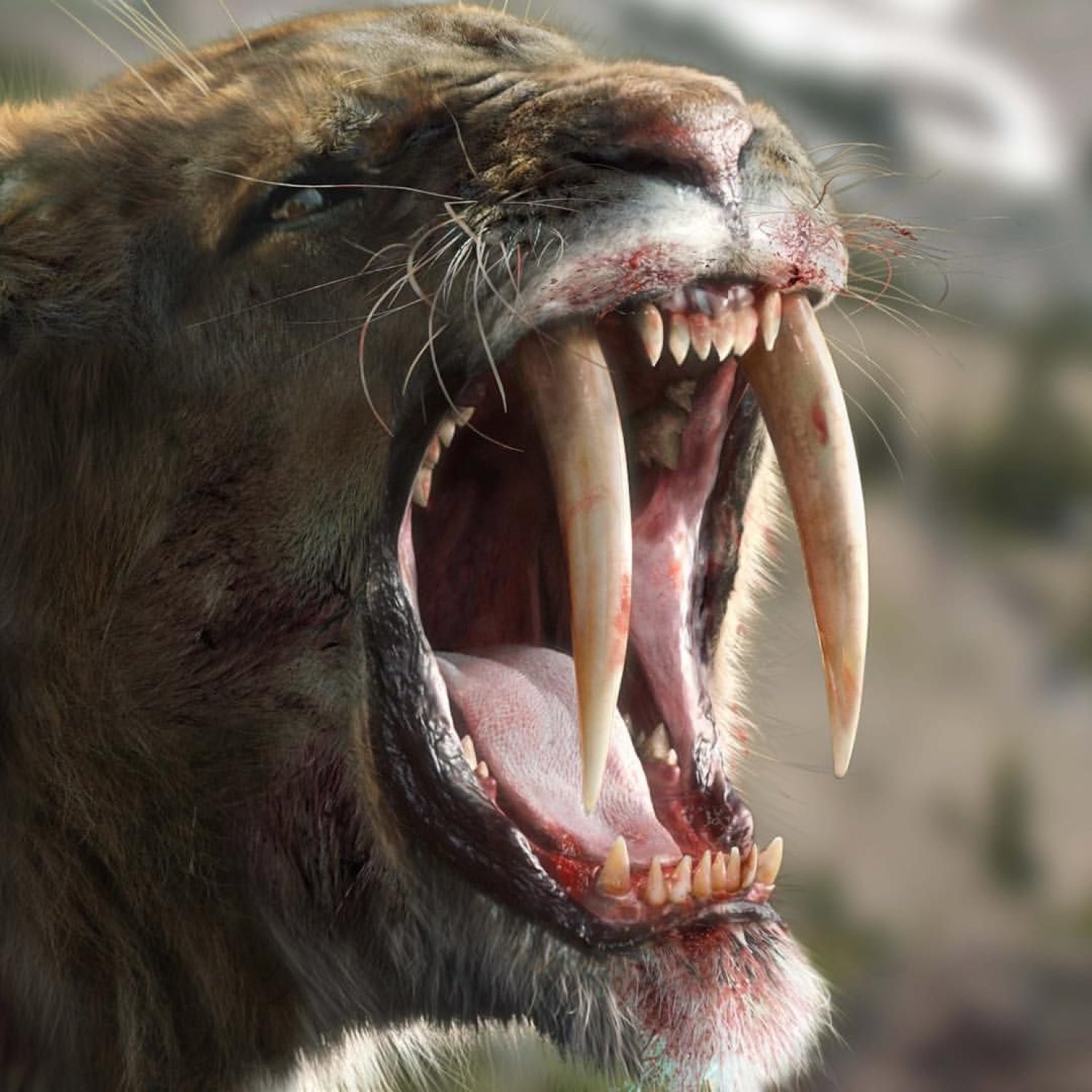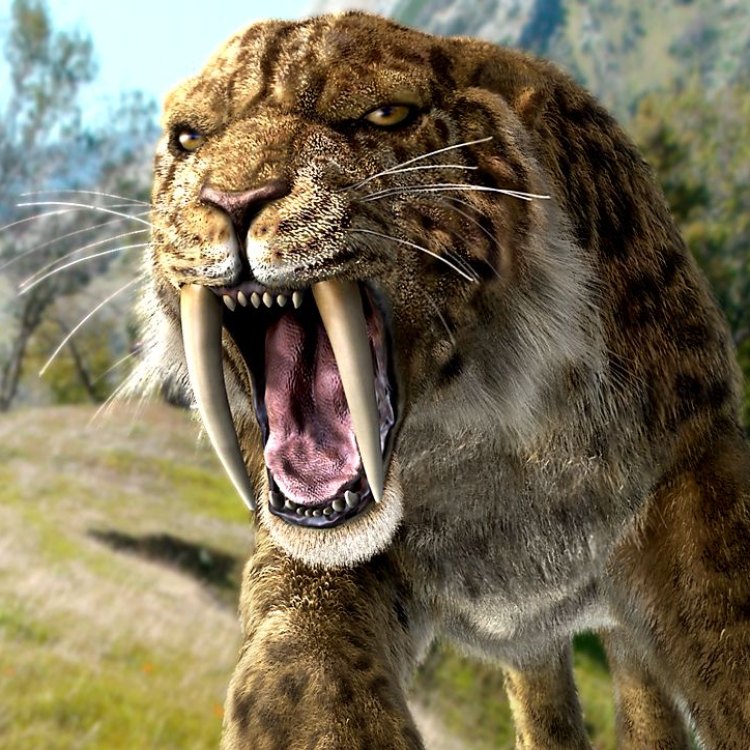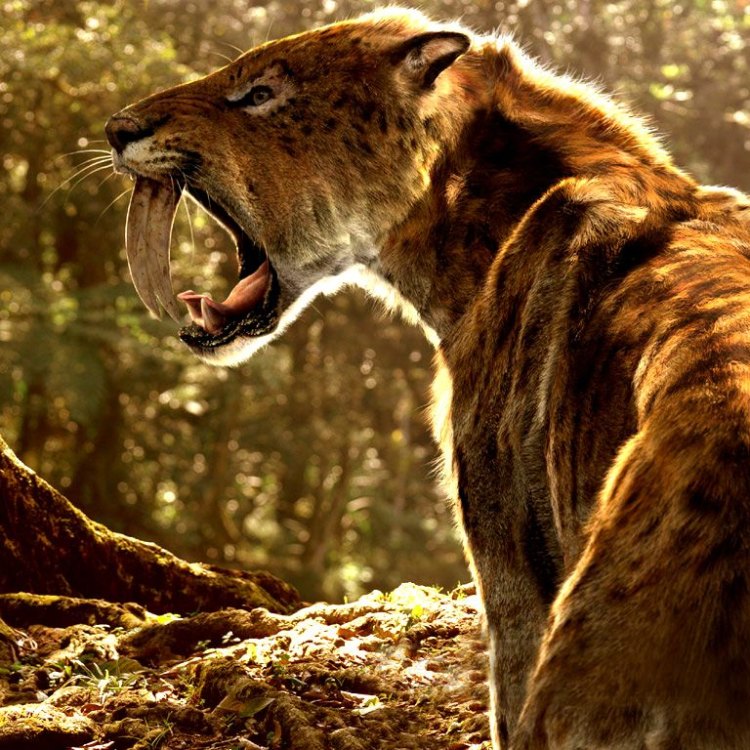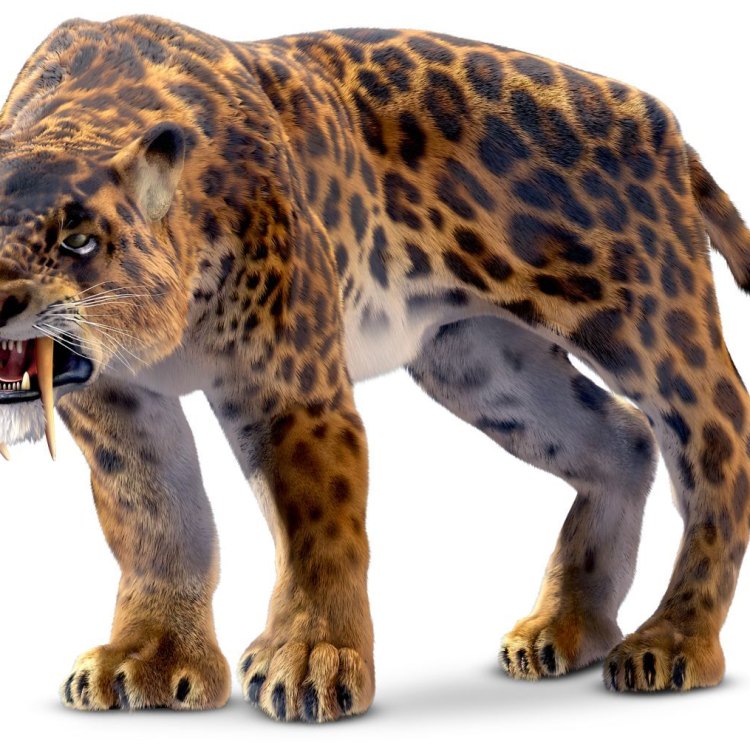
Saber Toothed Tiger
Approximately 1.5 to 2.5 meters (5 to 8 feet)
The Saber Toothed Tiger, from the Felidae family, was a fearsome and powerful animal with a distinct body shape. Its fossils have been found in different locations, and it was known to have an impressive length of 1.5 to 2.5 meters. Despite its shorter limbs compared to other big cats, it was still a formidable predator in the prehistoric world. #SaberToothedTiger #animals #prehistoric #fossils #Felidae #bigcats
Animal Details Summary:
Common Name: Saber Toothed Tiger
Kingdom: Animalia
Habitat: Grasslands, woodlands, and savannas
The Mighty Saber Toothed Tiger: The King of the Prehistoric Grasslands
As the name suggests, the Saber Toothed Tiger, also known by its scientific name Smilodon, was a fierce predator of the prehistoric era. Its iconic long, curved canines, measuring up to 7 inches, make the saber-toothed tiger one of the most recognizable animals in history.Being a large terrestrial mammal, the Saber Toothed Tiger belonged to the Felidae family, and although it shared many characteristics with present-day big cats, it was undoubtedly a unique and formidable species. Let's dive into the fascinating world of this ancient apex predator and uncover the secrets of its existence Saber Toothed Tiger.
Fierce Hunters of the Pristine American Grasslands
The Saber Toothed Tiger was an impressive beast that roamed the grasslands, woodlands, and savannas of North and South America around 2.5 million years ago. It is believed to have evolved from smaller cats and gradually evolved into a predator that could compete with other large animals such as mammoths, bison, and even other predators like the American lion.Its large size and muscular body, measuring up to 2.5 meters in length and weighing between 160 to 280 kilograms, made it one of the most dominant predators of its time. It was built for strength, with shorter limbs compared to other big cats, giving it a more powerful and compact body shape. This physical structure was ideal for taking down large mammals, even those bigger than itself, with minimal effort.
The Saber Toothed Tiger's Unique Adaptations
One of the Saber Toothed Tiger's most significant adaptations was its long, curved canines, which gave it a formidable hunting advantage. These razor-sharp teeth were perfect for piercing the flesh of its prey, delivering a fatal blow to its victim Spixs Macaw. However, this unique feature also had its limitations. The Saber Toothed Tiger's jaw muscles were not strong enough to generate the same biting power as modern-day big cats. instead, it used its long canines to immobilize its prey by targeting its neck or throat.Another distinctive feature of the Saber Toothed Tiger was its yellowish-brown fur with dark spots or stripes, much like the patterns we see on present-day big cats. This served as camouflage, allowing it to blend into its surroundings and make it harder for potential prey to spot it. The combination of its powerful body, sharp teeth, and stealthy appearance made the Saber Toothed Tiger a formidable predator, feared by many.
The Saber Toothed Tiger's Hunting Style
As a carnivorous mammal, the Saber Toothed Tiger preyed on a variety of animals, including bison, deer, and smaller mammals like rodents. Its hunting style differed from modern-day big cats, as it did not rely on speed and agility but rather its strength and stealth. Its shorter limbs gave it a slower rate of movement, so it had to rely on its sharp senses and camouflage to get close enough to its prey. Once it has found its target, it would use its long canines to quickly take down its victim in a swift, fatal attack.The Saber Toothed Tiger's Geographical Distribution
The Saber Toothed Tiger had a widespread geographical distribution as its fossils have been found in various locations. Bones and other remains of this ancient predator have been discovered in different parts of the United States, from the east coast to the west. The fossils have also been found in South American countries, such as Brazil, Argentina, and Venezuela. These findings suggest that the Saber Toothed Tiger had a widespread range, inhabiting a significant portion of the Americas during the Pleistocene epoch.The Legacy of the Saber Toothed Tiger
Despite going extinct over 11,000 years ago, the legacy of the Saber Toothed Tiger lives on. Fossil evidence and archaeological findings have helped scientists and researchers gather vital information about this magnificent creature’s anatomy, behavior, and habitat. This data has allowed us to gain a better understanding of the prehistoric world and the animals that roamed it.Moreover, the Saber Toothed Tiger's intimidating appearance and incredible hunting abilities have made it a popular subject in pop culture. It has been featured in numerous books, movies, and TV shows, cementing its place as one of the most iconic animals in history. However, its significance goes beyond entertainment. The Saber Toothed Tiger played a crucial role in the delicate balance of the prehistoric ecosystem, and its extinction had a significant impact on other species.
The Undying Fascination for the Saber Toothed Tiger
The Saber Toothed Tiger's remarkable evolution, fearsome appearance, and unique adaptations continue to capture the imagination of people worldwide. Its discovery and study have shed light on the dynamics of the prehistoric world and the evolutionary journey of big cats. It also holds valuable lessons about adaptation and survival, providing insight into how animals have evolved to suit their environment and thrive.Furthermore, the Saber Toothed Tiger serves as a stark reminder of how quickly species can go extinct. Despite being a dominant predator, this magnificent creature was unable to adapt to the changing environments and eventually faced extinction. Its fate serves as a critical lesson to the impact of human activities on the delicate balance of nature and the importance of conservation efforts to protect the world's natural wonders.
In Conclusion
The Saber Toothed Tiger, with its powerful body, sharp teeth, and stealthy hunting style, remains a revered and iconic figure in the animal kingdom. Its legacy continues to fascinate and educate us, and we owe it to this magnificent creature to preserve its memory and the lessons we can learn from its existence. The Saber Toothed Tiger is undoubtedly a timeless symbol of strength and survival that will continue to captivate our imagination for generations to come.

Saber Toothed Tiger
Animal Details Saber Toothed Tiger - Scientific Name: Smilodon
- Category: Animals S
- Scientific Name: Smilodon
- Common Name: Saber Toothed Tiger
- Kingdom: Animalia
- Phylum: Chordata
- Class: Mammalia
- Order: Carnivora
- Family: Felidae
- Habitat: Grasslands, woodlands, and savannas
- Feeding Method: Carnivore
- Geographical Distribution: North and South America
- Country of Origin: United States
- Location: Fossils found in various locations
- Animal Coloration: Yellowish-brown fur with dark spots or stripes
- Body Shape: Powerful and muscular, with shorter limbs compared to other big cats
- Length: Approximately 1.5 to 2.5 meters (5 to 8 feet)

Saber Toothed Tiger
- Adult Size: Similar to that of a modern tiger
- Average Lifespan: Estimated to be around 20 years
- Reproduction: Sexual reproduction
- Reproductive Behavior: Mating likely occurred in close proximity to hunting areas
- Sound or Call: Unknown
- Migration Pattern: No evidence of long-distance migration
- Social Groups: Solitary or lived in small family groups
- Behavior: Ambush predators that likely hunted larger mammals
- Threats: Climate change, habitat loss, and competition with other large predators
- Conservation Status: Extinct
- Impact on Ecosystem: Significant role as apex predators
- Human Use: Extensive study of their fossils
- Distinctive Features: Long, curved saber-like canine teeth
- Interesting Facts: Had some of the longest canine teeth of any known mammal
- Predator: Predator of large herbivores such as bison and horses

Smilodon
The Fearsome Predator of the Prehistoric World: Saber Toothed Tigers
The prehistoric world was full of terrifying creatures, and one of the most well-known is the saber toothed tiger. This magnificent predator roamed the Earth during the Pleistocene epoch, approximately 2.5 million to 10,000 years ago. While often depicted as a ferocious and deadly carnivore, there is much more to learn about these fascinating creatures beyond their iconic set of sharp teeth PeaceOfAnimals.Com.Saber toothed tigers, also known as Smilodon, were large felids that shared a striking resemblance to modern tigers. In fact, their adult size was similar to that of a modern tiger, with males reaching up to 500 kilograms and females up to 400 kilograms. However, what set them apart from their modern relatives were their distinctive features - their long, curved saber-like canine teeth.
These impressive canines were over 7 inches long and were used for taking down their prey. A common misconception is that saber toothed tigers used their teeth to stab their prey in the throat, but in reality, they used them for a different strategy. These teeth were actually designed for a precise and deadly bite, specifically targeting the jugular vein of their prey. This allowed them to efficiently take down large herbivores, such as bison and horses, which made up a significant portion of their diet.
But beyond their fearsome appearance and hunting techniques, saber toothed tigers had a complex social and reproductive life. Their average lifespan is estimated to be around 20 years, similar to that of modern tigers Siberian Ibex. They engaged in sexual reproduction, with mating likely occurring in close proximity to their hunting areas.
While there isn't much information available about their communication methods, it is believed that they communicated through vocalizations or body language. However, their exact sound or call remains unknown. What we do know is that they were solitary or lived in small family groups, unlike modern tigers, which are known for their social nature.
Saber toothed tigers were also known as ambush predators, meaning they would patiently wait for their prey to come to them rather than actively chasing them. Their large size and incredible strength allowed them to take down prey that was much larger than themselves, making them apex predators in their ecosystem.
But despite their formidable abilities, saber toothed tigers faced many threats, including climate change, habitat loss, and competition with other large predators, such as the American lion and dire wolves. As the Earth's climate began to change and ecosystems shifted, these prehistoric predators were unable to adapt and eventually became extinct.
Today, the only way to learn about saber toothed tigers is through extensive study of their fossils. These fossils have provided scientists with valuable information about their physical characteristics and behaviors, helping us to better understand these magnificent creatures.
One interesting fact about saber toothed tigers is that they had some of the longest canine teeth of any known mammal. But did you know that their canines actually continued to grow throughout their lives? This is known as continuous dental growth, a characteristic shared by many carnivorous mammals, including modern tigers.
So what was the impact of saber toothed tigers on the ecosystem? As apex predators, they played a significant role in regulating the population of large herbivores. Their presence also shaped the behavior of these herbivores, as they needed to constantly be on alert for potential attacks from these ferocious predators. With the extinction of the saber toothed tiger, the balance within their ecosystem was disrupted, leading to major changes in the food chain.
Although we will never be able to witness saber toothed tigers in their natural habitat, their fossils continue to fascinate and intrigue us. They are a symbol of the fierce and mysterious world that existed millions of years ago, and their unique features make them stand out among other prehistoric animals.
In conclusion, the saber toothed tiger was a fearsome and highly successful predator that dominated the prehistoric world. With their striking resemblance to modern tigers, impressive hunting strategies, and complex social behaviors, they continue to captivate our imagination. While they may be extinct, their legacy lives on through their distinct features and their important role in the ecosystem of the past.

The Mighty Saber Toothed Tiger: The King of the Prehistoric Grasslands
Disclaimer: The content provided is for informational purposes only. We cannot guarantee the accuracy of the information on this page 100%. All information provided here may change without prior notice.












